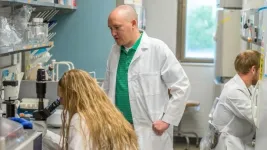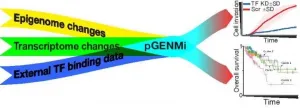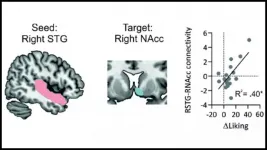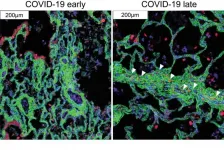Protein rewires metabolism to block cancer cell death, may allow cancer spread
2021-03-29
(Press-News.org) One specific protein may be a master regulator for changing how cancer cells consume nutrients from their environments, preventing cell death and increasing the likelihood the cancer could spread, a study from the University of Notre Dame has shown.
The study, published in Cell Reports, was completed in the laboratory of Zachary Schafer, the Coleman Foundation Associate Professor of Cancer Biology in the Department of Biological Sciences.
Schafer and collaborators found a protein called SGK1, known to be activated in a variety of cancer cell types, signals the cell to take up nutrients. These nutrients include glucose, which allows the cell to survive after it detaches from the scaffold of proteins it had been attached to, called the extracellular matrix. Non-cancerous cells often die after detaching from the extracellular matrix, but SGK1 activity promotes survival and therefore increases the chances that the cancer could spread, or metastasize.
"If you better understand precisely how cancer cells that are potentially metastatic survive in these sorts of foreign environments, then you can potentially antagonize those survival pathways and selectively cause those cells to die," said Schafer, also an affiliate member of Notre Dame's Harper Cancer Research Institute.
More than 90 percent of cancer deaths are caused by metastasis of cancer cells from one location to another, Schafer said. For instance, breast cancer can metastasize to the brain, and metastatic cancer cells need to adapt to the new environment there.
There are unique circumstances where the SGK1 protein is critically important, so there might be a vulnerability that researchers can target and alter the way the cells process their nutrients, said Schafer.
This discovery appears to be broadly relevant across many different types of cancer, Schafer said, with research in this paper focused on breast and colon cancer cells grown in cultures under different conditions. The research took place over a number of years, and in addition to a collaboration with the Duke University School of Medicine and Northwestern University Feinberg School of Medicine, several Notre Dame postdoctoral, graduate and undergraduate researchers assisted with the work.
The next step in the research is to complete a "proof of principle" study, which is an early-stage investigation of how this knowledge could be leveraged for clinical benefit. Such a study could reveal if different agents -- which could become therapeutics -- could potentially eliminate the cells in question.
"If you can kill those cells that are potentially metastatic, then potentially you can get to a point where you can block cancer dissemination," Schafer said.
INFORMATION:
The study was funded by the American Cancer Society, the Phi Beta Psi National Project, the Coleman Foundation, the National Science Foundation (through a Research Experience for Undergraduate grant) and the Malanga Family Excellence Fund for Cancer Research.
[Attachments] See images for this press release:

ELSE PRESS RELEASES FROM THIS DATE:
2021-03-29
LOS ALAMOS, N.M., March 29, 2021--A first-of-its-kind instrument that samples smoke from megafires and scans humidity will help researchers better understand the scale and long-term impact of fires--specifically how far and high the smoke will travel; when and where it will rain; and whether the wet smoke will warm the climate by absorbing sunlight.
"Smoke containing soot and other toxic particles from megafires can travel thousands of kilometers at high altitudes where winds are fast and air is dry," said Manvendra Dubey, a Los Alamos National Laboratory atmospheric scientist and co-author on a paper published last week in Aerosol Science and Technology. "These smoke-filled clouds can absorb ...
2021-03-29
Among patients who return to work after a heart attack, those who work more than 55 hours per week, compared to those working an average full-time job of 35-40 hours a week, increase their odds of having a second heart attack by about twofold, according to a prospective cohort study published today in the Journal of the American College of Cardiology.
Data from the International Labour Office estimates 1 in 5 workers worldwide work over 48 hours per week. Previous studies have found an association between working long hours and increased risk of coronary heart disease and stroke. This is the first study of its kind to examine the effect of long working hours and the risk of a second cardiovascular event ...
2021-03-29
Firearm injuries are a leading and preventable cause of injury and death among youth - responsible for an estimated 5,000 deaths and 22,000 non-fatal injury hospital visits each year in American kids. And while hospital systems are poised to tackle this issue using a public health approach, prevention efforts and policies may be differentially effective. A new study led by researchers at Children's National Hospital, finds that sociodemographic factors related to intent of injury by firearm may be useful in guiding policy and informing tailored interventions for the prevention of firearm injuries in at-risk youth.
"We sought to explore differences by injury intent in a ...
2021-03-29
DALLAS - March. 29, 2021 - With NASA preparing to send humans to Mars in the 2030s, researchers are studying the physical effects of spending long periods in space. Now a new study by scientists at UT Southwestern shows that the heart of an astronaut who spent nearly a year aboard the International Space Station shrank, even with regular exercise, although it continued to function well.
The results were comparable with what the researchers found in a long-distance swimmer who spent nearly half a year trying to cross the Pacific Ocean.
The study, published today in Circulation, reports that astronaut Scott Kelly, now retired, lost an average of 0.74 grams - about three-tenths of an ounce - per week in the mass ...
2021-03-29
Although the development of secondary cancerous growths, called metastasis, is the primary cause of death in most cancers, the cellular changes that drive it are poorly understood. In a new study, published in Genome Biology, researchers at the University of Illinois Urbana-Champaign have developed a new modeling approach to better understand how tumors become aggressive.
"Researchers have identified several cellular pathways that change when a tumor becomes aggressive. However, it is difficult to understand how they affect the tumor," said Steven Offer, an assistant professor of molecular pharmacology and experimental therapeutics at Mayo Clinic, Minnesota. "We wanted to develop a simple system that can model how cancer cells form ...
2021-03-29
FINDINGS
A new study by researchers at the UCLA Jonsson Comprehensive Cancer Center found using percutaneous image guided needle based thermal ablation -- the precise application of extreme heat or cold to a tumor using sophisticated ultrasound, CT or MRI in a single outpatient session -- is a safe and effective adjunctive therapy for the local control of metastatic gynecologic cancers throughout lungs, liver, soft tissues in the abdomen and pelvis and bones in patients with advanced localized cancers unresponsive to systemic therapy.
Nearly 96% of the patients in the study achieved a complete tumor response over a median follow up period of 10 months. The overall survival rate was 37.5 months and the progression-free ...
2021-03-29
BOSTON - In the last 20 years, Black adults living in rural areas of the United States have experienced high mortality rates due to diabetes, high blood pressure, heart disease and stroke compared to white adults. In a research letter written by colleagues at Beth Israel Deaconess Medical Center (BIDMC) and published in the END ...
2021-03-29
Age-related macular degeneration (AMD), which leads to a loss of central vision, is the most frequent cause of blindness in adults 50 years of age or older, affecting an estimated 196 million people worldwide. There is no cure, though treatment can slow the onset and preserve some vision.
Recently, however, researchers at the University of Rochester have made an important breakthrough in the quest for an AMD cure. Their first three-dimensional (3D) lab model mimics the part of the human retina affected in macular degeneration.
Their model combines stem cell-derived ...
2021-03-29
Communication between the brain's auditory and reward circuits is the reason why humans find music rewarding, according to new research published in JNeurosci.
Despite no obvious biological benefits, humans love music. Neuroimaging studies highlight similarities between how the brain's reward circuits process music and other rewards like food, money, and alcohol. Yet neuroimaging studies are correlational by nature. In a new study, Mas-Herrero et al. sought to nail down the causal role of this circuitry by using non-invasive brain stimulation.
A group of pop music fans listened ...
2021-03-29
A team led by investigators at Weill Cornell Medicine and NewYork-Presbyterian has used advanced technology and analytics to map, at single-cell resolution, the cellular landscape of diseased lung tissue in severe COVID-19 and other infectious lung diseases.
In the study, published online March 29 in Nature, the researchers imaged autopsied lung tissue in a way that simultaneously highlighted dozens of molecular markers on cells. Analyzing these data using novel analytical tools revealed new insights into the causes of damage in these lung illnesses and a rich data resource for further research.
"COVID-19 is a complex disease, and we still don't understand exactly what it does to a lot of organs, but with this study we were able to develop ...
LAST 30 PRESS RELEASES:
[Press-News.org] Protein rewires metabolism to block cancer cell death, may allow cancer spread






